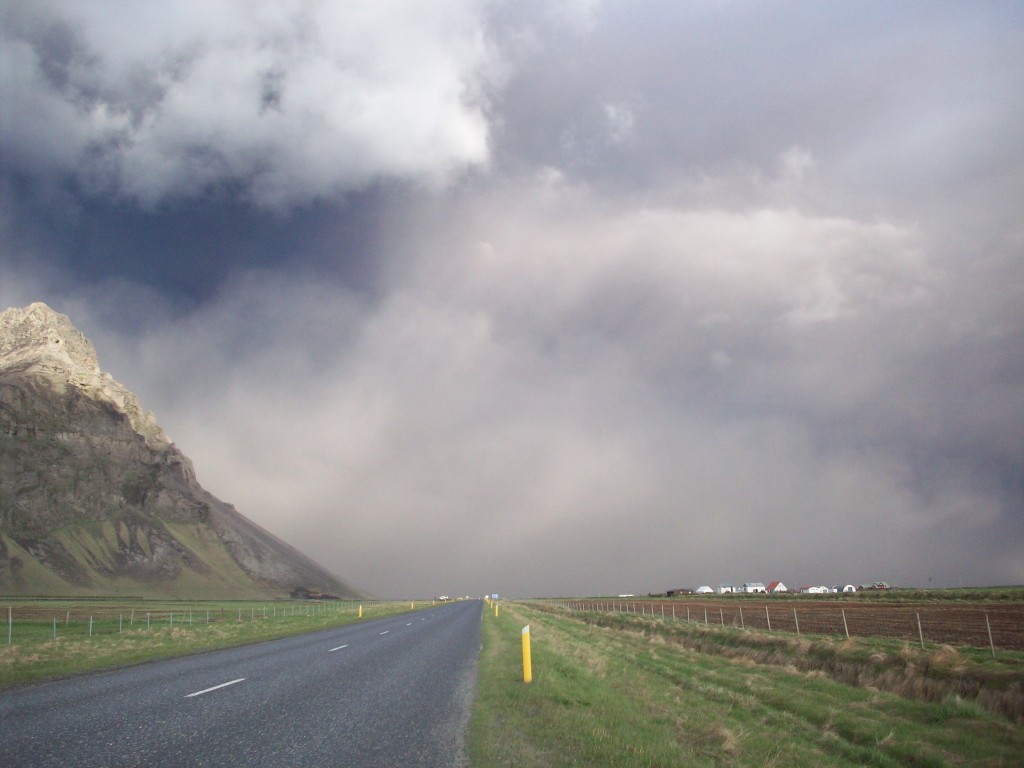Note, please skip this self-indulgent post if you come here for economic commentary.
If you are about my age (and male) you might remember those schlocky sci-fi paperbacks from the 1950s and 60s, with cover art showing a rocket sitting on a moon of Saturn. Perhaps the picture showed light from a distant sun shining dimly through Titan’s methane atmosphere. Oddly-shaped rocks rise out of orange-tinted lakes of ammonia. Did it make you want to become an astronaut? Then go to Iceland.
I arrived in Iceland last Thursday at 3:15, and initially didn’t see anything like the scene I just described. The airport was delightfully spacious and empty. It had those clean, utilitarian lines one associates with Scandinavian architecture, with lots of light everywhere. By 3:30 I had rented a (very expensive) Subaru, and was driving through the most crystal clear air I had ever seen–or should I say not seen. Reykjavik was clearly visible 20 miles away over the water, as was the peninsula to the north, which must be 60 miles away. Partly this reflects a lack of air pollution, but the atmosphere in the polar regions is much clearer than even unpolluted air in more temperate climes.
I drove for at least 6 or 8 miles through the outskirts of Reykjavik. As you may know, Iceland has become virtually a city-state, with 2/3 of the population living near the capital. I want to assure the IceSave depositors of Britain and Holland that their money was well-spent, as Icelanders are enjoying many new and attractive residences in the “Scandinavian moderne” style.
Right after leaving Reykjavik the road turned west, and I was surprised to see a huge pillar of ash rising far above the clouds in the distance. Looking at the map, I figured the volcano must be roughly 100 km away. I decided to see how close I could get before I ran into a government barricade to keep people away from danger. (Later I found out that there are no such barricades, in Iceland you are quite free to drive into a pool of lava.)
Because there are almost no trees, the country seems very wide open and spacious. It is relatively easy to find what you are looking for. You see steam coming out of the ground, lots of rivers, ancient lava flows, etc. When I got much nearer to the volcano, I came across the beautiful waterfall called Seljalandsfoss. You can actually walk behind it. As an aside, when planning a back and forth trip, always try to keep the sun at your back, it makes the scenery look much better. Thus I drove east in the afternoon, with the plan to return west to Reykjavik the next day. The late afternoon sun made the landscape look stunning beautiful. And in May the “afternoon” last until the sun sets at 10:30.
Picture this scene. You are a few 100 meters from a tall cliff. Straight ahead is an extremely attractive waterfall. Other slender waterfalls flow over the cliff to your left. To the right you look across flat farmland with Icelandic horses grazing, and out over the ocean to the jagged Westerman Islands. Beyond that is Surtsey, which didn’t even exist until 1963. Above the cliffs you see a dazzling glacier, and the sort of oddly shaped clouds that you see in northern regions. Cute puffin birds circle around. Over-arching the entire scene is a huge rainbow with more colors than I recall seeing in any other rainbow. Oh, and one other thing, if that’s not enough there was also a colossal tower of ash rising above the glacier-caped volcano, no more than a few miles away.
The ash cloud was drifting down and to the right (which is south, or out to sea.) A few miles further on the road seemed to disappear into the ash cloud. Just then I saw a sign for a hotel named “Anna,” which lay right at the foot of the volcano. As I drove up I assumed there would be no rooms. After all, the views were sublime, so I figured they must be swamped with tourists. I was delighted to find that they did have a very nice room, and at a reasonable price. It was a small family operation (they seemed to be farmers) with only 12 rooms. Later I found out that I was the only person staying there. As an aside, it is really relaxing to travel in thinly-populated, developed countries (Iceland, Australia, NZ, etc). In the morning I walked out of my room and went to breakfast without out even closing the door to my room (which opened onto a lobby that was more like someone’s living room.)
The family was quite friendly. They told me that there was an even more impressive waterfall just 15 km down the road. They said you pass through the ash cloud after about 5 km, and then it is clear on the other side. I asked whether it was a problem to take the rental car into the ash, and they said no problem. (Later I found out that the rental car company didn’t see things that way. Tip: If you do what I did, drive slowly.)
When I first entered the greyish-brown curtain of ash, it seemed like a sort of fog. After 5km, the ash cloud was getting really dark, almost like night. A few more km and it was darker than night. By the 10 km point it was darker than anything I had ever experienced, save for when I was young and explored a wild cave in southwestern Wisconsin. It felt like a blanket had covered the entire planet. You almost had the feeling that the Earth had disappeared, or that you were all alone in a post-apocalypse world. Yet 10 miles back there was bright sunshine. I now can understand the sort of primal fear people felt during a total eclipse of the sun, wondering whether the sun would ever reappear. I suppose this sounds silly, but I couldn’t help wondering if the volcanic eruption had gotten worse. After all, the Anna Hotel people lived in the area, and said it was a quick 5k drive to clear air on the other side. But things just kept getting darker and darker.
And then came one of those serendipitous moments that you cannot plan for, but simply happen a few times in each person’s life. On the left and straight ahead were high cliffs, perhaps 1000 feet high. I could not see them. And high overheard was nothing but inky blackness. Not black like the night sky; that always gives one a feeling of spaciousness. But rather a claustrophobic blackness. But between the cliffs and the overhead clouds, a very faint band of light became visible. I don’t know what color it was, probably mauve or salmon or something. But since I’m a guy I’ll just say “orange.” In the foreground the dim light illuminated pools of water on the left side of the road. And rising out of the exceedingly dimly-lit orangish pools was bizarrely twisted towers of volcanic rock. Finally, at age 54, I achieved my boyhood goal of visiting Titan.
[If you plan to recreate my little adventure, bring along some ominous music to play in the rental car. Perhaps Gorecki’s 3rd; then the lighter movements will kick in about the time the first dim light breaks through.]
Even when I reached the big waterfall at 15k, everything was still very brown and dark, but no longer completely black. It looked like brown mud pouring over the cliff. Ash fell like snow in my hair. And here is the most astounding thing of all. People live in this ash cloud! I saw lights in people’s houses. This is a farming region, and my sense is that the farmers (and fisherman) of Iceland are not wimps like us western urbanites, and would laugh at my nervousness on approaching the volcano. In 1973, 500o people were rescued from the Westerman islands, in the middle of the night, as a volcanic eruption was rapidly burying their houses. They have since moved back and rebuilt. But the ash is hurting the farmers who live near the volcano.
The next morning the ash cloud had shifted dramatically to the west, so I would have to drive through it again while returning to Reykjavik. And the weather was now rainy. As I approached the ash cloud, it looked like one of those Midwestern super-cells, except that it arched from one horizon to the other. Underneath the rain became heavier–in two different ways. First, it rained much harder. And second, it was raining mud. But I could actually see much more easily this time, as the rain washed so much ash out of the air that visibility was no worse than during a rainstorm.
Because my plane didn’t leave until 5:00, I was able to visit the massive Gullfoss falls, as well as Geyser. No, I don’t mean “a geyser.” I mean the one that all others are named after. And also the big crack in the earth where North American and European plates are drawing ever further apart (at least while Bush was president, perhaps things have changed under Obama.) I also did a quick tour of Reykjavik, and was back at the airport by 3:00. Here’s my suggestion. Anyone planning a trip to Europe should take Icelandair, and spend 24 hours in Iceland on the return. You won’t have exactly the same experience I had, but it can’t help but provide more marginal utility than one more day traipsing around the continent.
By the way, when I arrived at the airport it was deserted. It seems the shift in the ash clouds caused all flights to be cancelled. So make that 48 hours in Iceland. I spent the extra time touring Reykjavik, and also made the obligatory stop at the Blue Lagoon. The latter is certainly amazing, but had a certain Disneyesque feel after the sublime sights I had seen on Thursday.
Things I didn’t know about Iceland:
1. If a family of four has one boy and one girl, all four family-members will have different last names.
2. Icelanders aren’t pure Scandinavians, they’re 40% Celtic. The Vikings grabbed Irish brides on their way west.
3. In 1627 Algerian pirates attacked the Westerman islands, killing 40 and taking 250 people to be sold into slavery. Who would have thought that Africans enslaved Icelanders? (Yes, I know that Algerians enslaved many Europeans, but I assumed those were mostly people around the Mediterranean.) So what was the big news in the 1620s? At the time I suppose Europeans were focusing on “Islamic terrorists.” But in the long run it was the English settlement of Massachusetts. This reminds me of 1979. At the time it seemed like the Iranian hostage crisis was the big story. But in the long run it will be Deng’s decision to move China toward a market economy.
4. Reykjavik is much more sophisticated than the average Western metro area of 200,000. Yes, it is the capital, but it can’t be that unrepresentative, if it has 2/3 of Iceland’s people.
5. During the boom, Iceland attracted immigrants from places like Poland, Thailand and Namibia. Many are still there, as the rural economy (especially fishing) is actually helped by the weak kroner.
6. Germany attacked Iceland in 1944. [Update, commenters tell me “one German” attacked Iceland.]
7. To be considered a real Icelandic man, you must swim naked to an island 5 miles off the north coast, all the while holding a flaming torch and singing the national anthem.
8. Icelanders consider other Scandinavians to be a bit too proper and uptight.
Go to Iceland. Right now. If you prefer Lord of the Rings sublime to sci-fi strangeness, you can take a jeep up the side of the volcano and see the lava shoot up at night. And as an added surprise, the lava jets are surrounded by lots of lightning bolts. I didn’t see this but talked to a tourist who did. Oddly there is no sound. Maybe the ash muffles the lightning.
Here’s my hotel–in real life the ash looks closer.
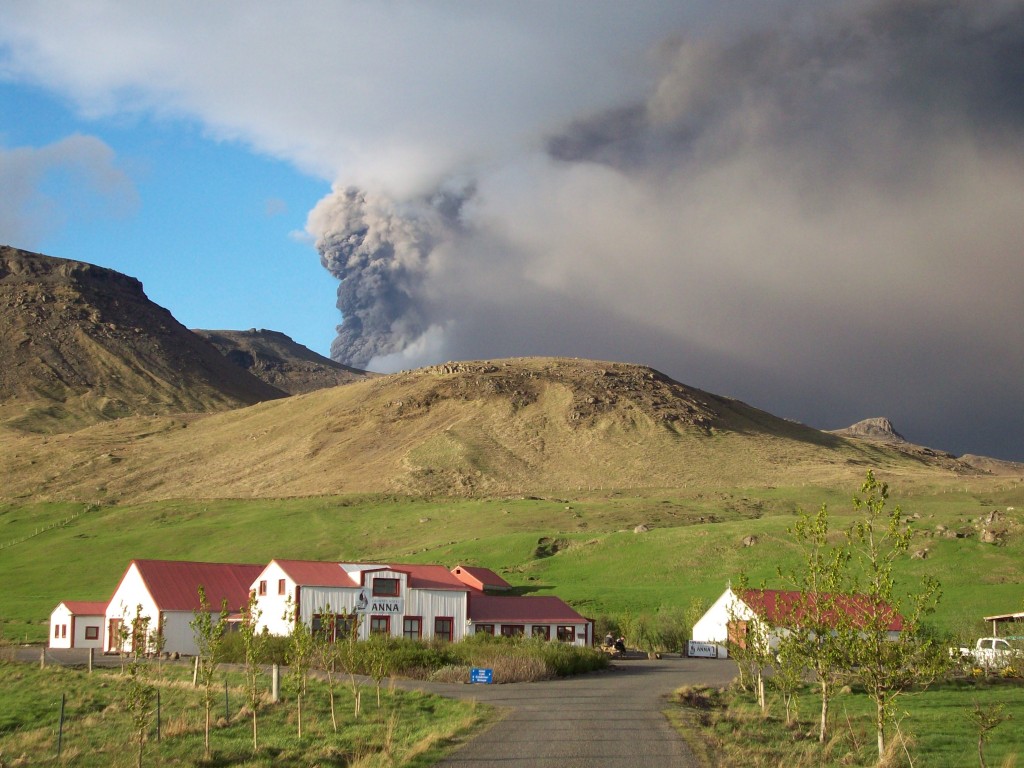
Here is the “safety rope” at the Gullfoss falls:
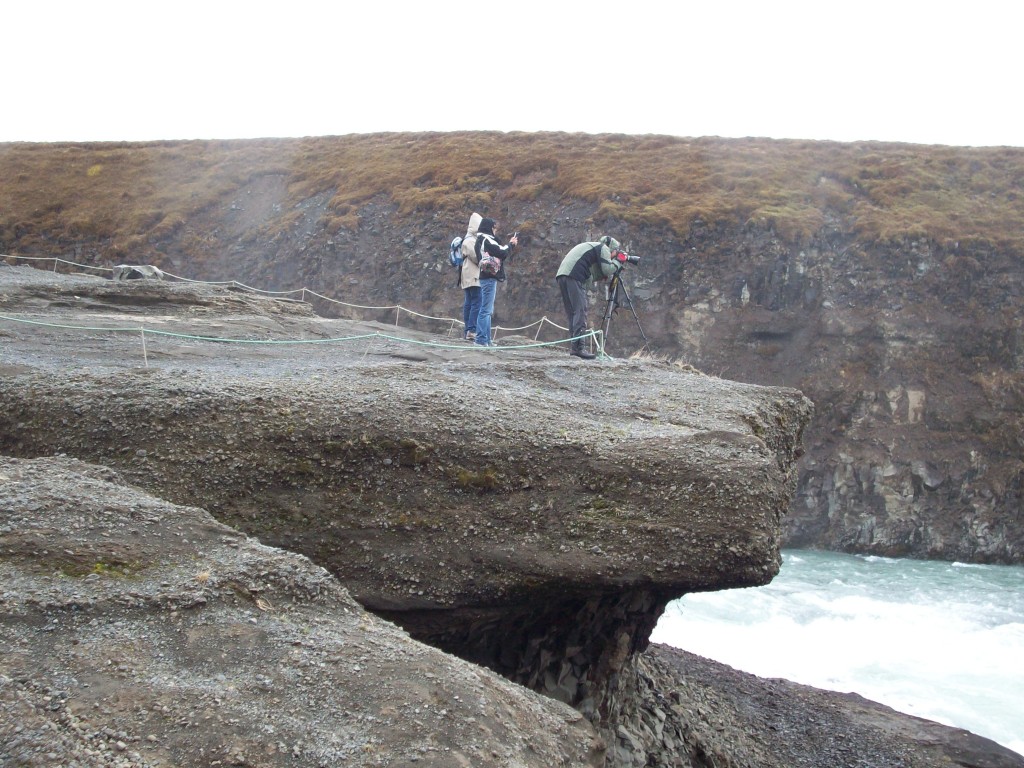
Here’s a better view:
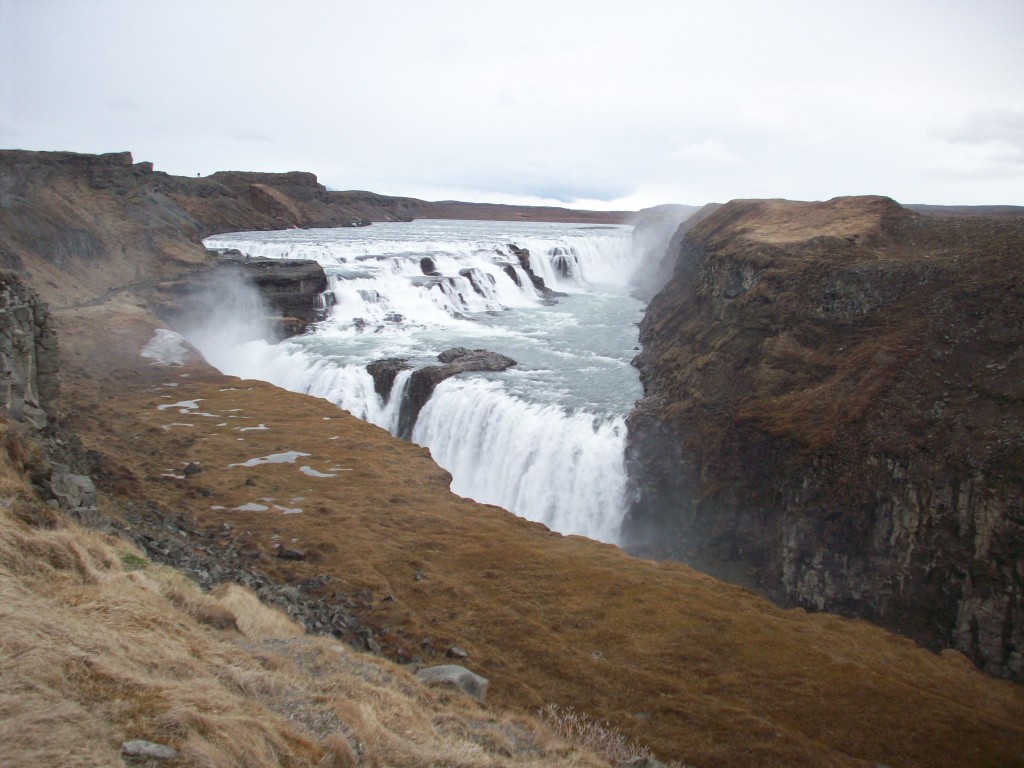
And the first waterfall I saw (viewed from behind, note two people right center):
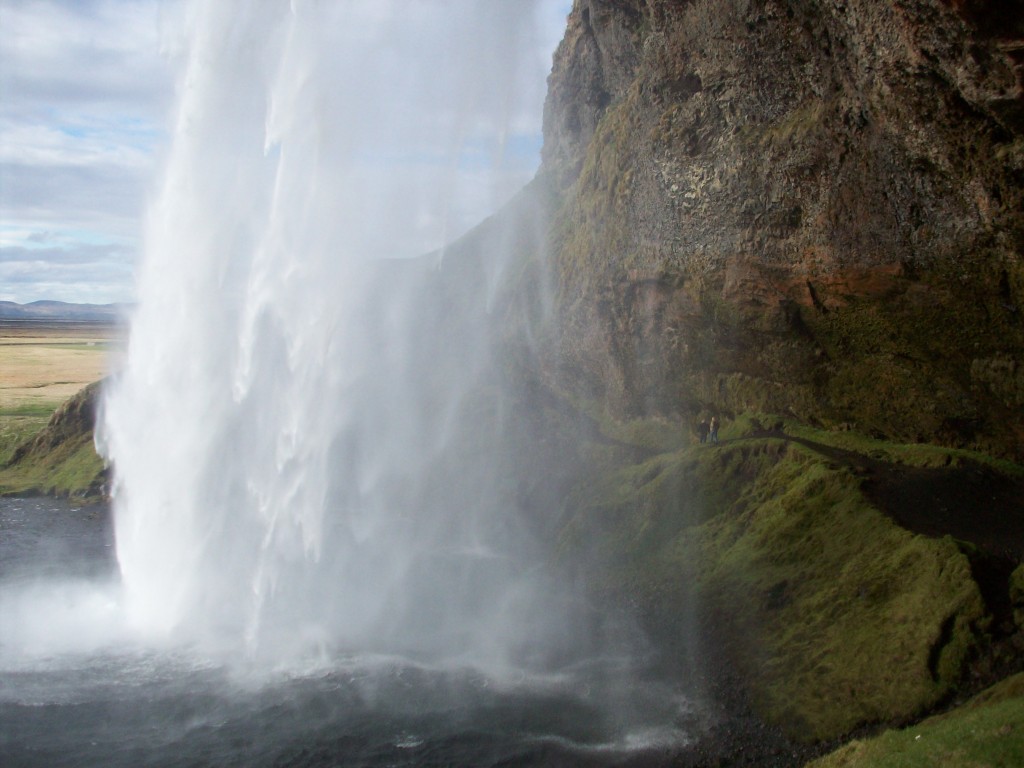
Approaching the ash cloud:

Getting closer:
